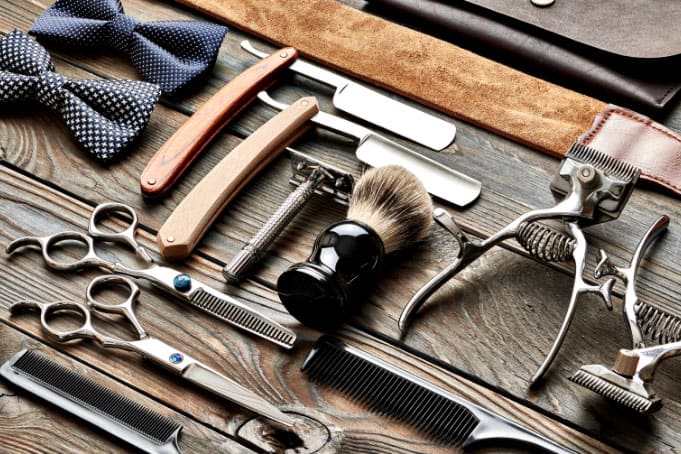
Barbering is one of the oldest professions in human history. We will discuss the history of barbering in a later blog.
This blog focuses on the common barbering tools of the trade and how they have changed significantly over the last two centuries. The advancements in tools and techniques during this period have revolutionised the craft, allowing barbers to provide more precise, efficient, and creative services. Over the past 200 years, technology and innovation have significantly impacted modern barbering.
The 19th Century: The Rise of Safety and Standardisation
The 19th century saw a shift towards more standardised and user-friendly barbering tools. The straight razor, a barbering staple, peaked in craftsmanship during this era. Made from high-carbon steel, these razors featured elegantly crafted handles made from wood, bone, and even ivory. They required regular maintenance with a leather strop to keep the blades sharp and effective.
Another significant development was the invention of the safety razor. In 1880, Frederick and Otto Kampfe patented the first safety razor (Star Safety Razor), which incorporated a protective guard to minimise cuts and nicks. Initially, this was sold to friends and customers as the Kampfe’s rake. This innovation began safer shaving practices in barbershops and at home, with over 60 companies filing razor patents. Later, in 1901, King C. Gillette refined this concept by introducing disposable blades, which made shaving more hygienic and convenient.
Combs and brushes also improved over this period using materials like tortoiseshell and fine wood; these tools were designed for durability and ease of use. Barbers relied on them to detangle, style, and precisely shape hair.
The Early 20th Century: Mechanisation and Efficiency
The 20th century ushered in a wave of mechanisation in barbering tools. One of the most groundbreaking inventions was the electric clipper, developed by Leo J. Wahl in 1919. Electric clippers revolutionised haircutting by enabling barbers to work faster and more accurately. These devices featured motorised blades that could handle various hair lengths and textures, making them an essential tool in all barbershops.
Alongside clippers, scissors and shears also underwent significant improvements. The introduction of stainless steel blades in the early 1900s made these tools more durable and rust resistant. Ergonomic designs emerged, reducing barbers’ hand fatigue during long work hours. Specialised thinning shears became popular for blending and texturising hair, allowing for more sophisticated hairstyles.
Shaving brushes, typically made from boar or badger hair, became essential tools for lathering shaving cream and preparing the skin for a close shave. Paired with straight or safety razors, these brushes helped create a luxurious and practical shaving experience.
Mid-20th Century: Diversification of Tools
The mid-20th century saw an explosion in the variety of barbering tools. Electric razors, introduced by companies like Schick and Remington, offered a quick and convenient alternative to traditional shaving methods. These devices used oscillating or rotating blades and became popular for men seeking a low-maintenance grooming routine.
Hairdryers also debuted in barbershops during this time, allowing for quicker styling and finishing touches. Initially bulky and less efficient than today’s models, these early hairdryers still marked a significant advancement in hairstyling technology.
Hot towel steamers and facial massage rollers became common as barbers expanded their services to include facial treatments. These tools reflected a growing emphasis on relaxation and skin care as part of the grooming experience.

Late 20th Century to Present: Precision and Personalisation
The late 20th century and early 21st century brought a fusion of tradition and cutting-edge technology to barbering. Cordless electric clippers and trimmers emerged, offering barbers greater flexibility and mobility. Modern clippers now feature adjustable blades, detachable guards, and powerful motors, allowing for precise fades, tapers, and designs.
Straight razors have also seen a resurgence, with many barbers opting for replaceable blade systems to combine traditional techniques with modern hygiene standards. Safety razors remain widespread, with advancements like pivoting heads and lubricating strips enhancing the shaving experience.
Shears have continued to evolve, with high-carbon stainless steel and titanium alloys providing sharper, longer-lasting blades. Innovations such as micro-serrated edges and offset handles allow barbers to execute intricate cuts with minimal effort.
Today, barbers also use specialised tools for beard grooming, including beard trimmers, shaping combs, and precision scissors. These tools enable the creation of well-defined lines and contours, catering to the growing demand for personalised beard styles.
The Role of Technology
Technology has further transformed barbering in recent years. Laser-guided trimmers and smart clippers with digital displays are now part of the professional toolkit, ensuring accuracy and efficiency. Heat styling tools like flat irons and curling wands have expanded the range of hairstyles barbers can offer. Additionally, haircare products like sprays, pomades, and gels have become integral to styling, adding texture and hold.
Eco-conscious trends have influenced the industry, with tools made from sustainable materials and refillable product systems gaining traction. Barbers are increasingly adopting practices that prioritise both quality and environmental responsibility.
A Legacy of Craftsmanship
The evolution of barbering tools over the last 200 years underscores the profession’s adaptability and dedication to excellence. Each innovation has built upon past traditions, enhancing the barber’s ability to serve clients with precision and artistry.
As barbering continues to evolve, the tools of the trade will undoubtedly reflect the ongoing pursuit of innovation and craftsmanship. From the humble straight razor to today’s high-tech gadgets, these tools remain a testament to the enduring art of barbering.






